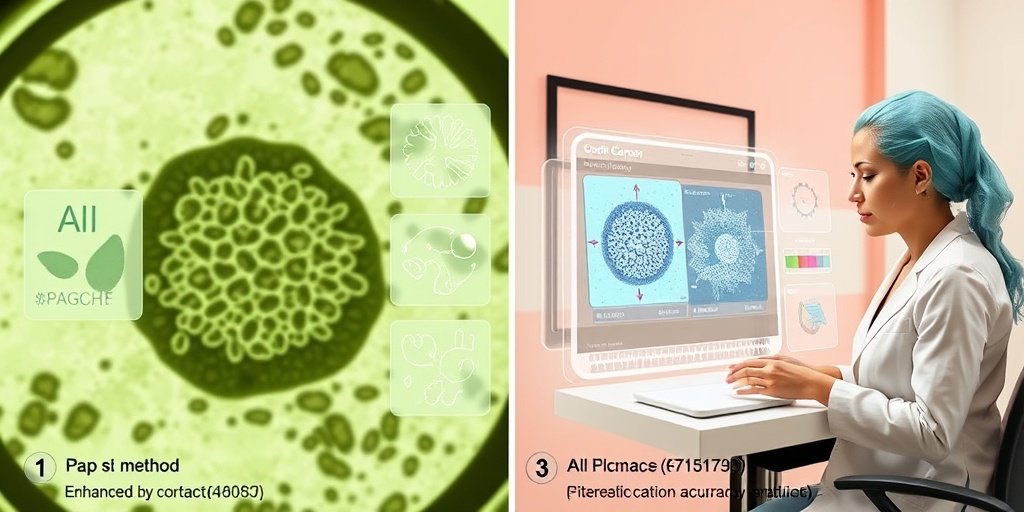⚡ Quick Summary
This study presents a novel approach to cervical cancer detection by utilizing DPAGCHE-enhanced Pap smear images and Convolutional Neural Network (CNN) models. The ResNet50 model achieved an impressive 84.15% accuracy, demonstrating the effectiveness of enhanced image preprocessing in improving classification performance.
🔍 Key Details
- 📊 Dataset: Herlev dataset, consisting of Pap smear images
- 🧩 Features used: Preprocessed images enhanced using DPAGCHE
- ⚙️ Technology: Transfer learning with pre-trained CNN models, including ResNet50
- 🏆 Performance: ResNet50: 84.15% accuracy, 53.65% increase in F1-score
🔑 Key Takeaways
- 📊 Automated classification of cervical cancer can significantly enhance detection accuracy.
- 💡 DPAGCHE preprocessing improves image quality by enhancing contrast and reducing noise.
- 👩🔬 Transfer learning with CNNs allows for effective classification of complex datasets.
- 🏆 ResNet50 outperformed other models, highlighting the benefits of deeper architectures.
- 🤖 Data augmentation techniques help prevent overfitting and improve model robustness.
- 🌍 Study conducted using MATLAB Online for implementation and evaluation.
- 🆔 Study published in PLoS One, showcasing significant advancements in cervical cancer detection.

📚 Background
Cervical cancer remains a leading cause of mortality among women globally, primarily due to the challenges associated with early detection. Traditional diagnostic methods often struggle with issues such as contrast and noise in Pap smear images, which can hinder accurate classification. The integration of advanced image processing techniques and machine learning offers a promising avenue for improving diagnostic accuracy and efficiency.
🗒️ Study
This study aimed to evaluate the impact of the DPAGCHE method on the classification performance of Pap smear images. By employing transfer learning with pre-trained CNN models, the researchers classified images into three categories. The study utilized data augmentation techniques, including rotations, flips, and shifts, to enhance variability and prevent overfitting, ultimately leading to improved model performance.
📈 Results
The results revealed that the ResNet50 model trained on DPAGCHE-enhanced images achieved the highest classification performance, with an accuracy of 84.15%. This model also demonstrated significant improvements in specificity, recall, precision, and F1-score, with a remarkable 53.65% increase in F1-score and a 44.29% increase in precision. In contrast, the baseline CNN model only reached 66.67% accuracy, underscoring the advantages of enhanced preprocessing and deeper architectures.
🌍 Impact and Implications
The findings of this study have profound implications for the field of cervical cancer detection. By integrating DPAGCHE-enhanced preprocessing with deep learning techniques, healthcare professionals can significantly improve the accuracy of automated cervical cancer detection systems. This advancement not only enhances diagnostic capabilities but also has the potential to reduce mortality rates through earlier and more reliable detection.
🔮 Conclusion
This study highlights the transformative potential of combining advanced image preprocessing techniques with deep learning in the realm of cervical cancer detection. The impressive performance of the ResNet50 model reinforces the importance of addressing image quality issues in diagnostic processes. As we move forward, further research and development in this area could lead to even more effective tools for early detection and improved patient outcomes.
💬 Your comments
What are your thoughts on the integration of advanced image processing and machine learning in cancer detection? We would love to hear your insights! 💬 Leave your comments below or connect with us on social media:
Comparative analysis of cervical cancer classification of DPAGCHE-enhanced Pap smear images using convolutional neural network models.
Abstract
Cervical cancer remains a significant cause of female mortality worldwide, primarily due to abnormal cell growth in the cervix. This study proposes an automated classification method to enhance detection accuracy and efficiency, addressing contrast and noise issues in traditional diagnostic approaches. The impact of image enhancement on classification performance is evaluated by comparing transfer learning-based Convolutional Neural Network (CNN) models trained on both original and enhanced images. This study employs transfer learning with pre-trained CNNs to classify preprocessed Pap smear images into three categories. Data augmentation, including rotations, flips, and shifts, enhances variability and prevents overfitting. The OneCycle learning rate schedule dynamically adjusts the learning rate, improving training efficiency. To enhance image quality, the Denoised Pairing Adaptive Gamma with Clipping Histogram Equalization (DPAGCHE) method improves contrast and reduces noise. The evaluation involves five pre-trained CNN models and the publicly available Herlev dataset, implemented in MATLAB Online. The ResNet50 model trained on the DPAGCHE-enhanced dataset achieves the highest classification performance, with 84.15% accuracy, along with improved specificity, recall, precision, and F1-score. ResNet50’s residual connections mitigate vanishing gradient issues and enhance deep feature extraction. Accordingly, the DPAGCHE preprocessing significantly improves classification performance, leading to a 53.65% increase in F1-score and 44.29% in precision. In contrast, the Baseline CNN reaches only 66.67% accuracy, highlighting the advantage of deeper architectures combined with enhanced preprocessing. These findings suggest integrating DPAGCHE-enhanced preprocessing with deep learning improves automated cervical cancer detection. In particular, ResNet50 demonstrates the best performance, reinforcing the effectiveness of contrast enhancement and noise reduction in aiding classification models.
Author: [‘Khiruddin K’, ‘Mustafa WA’, ‘Islam MA’, ‘Jamaludin KR’, ‘Alquran H’, ‘Rahman KSA’]
Journal: PLoS One
Citation: Khiruddin K, et al. Comparative analysis of cervical cancer classification of DPAGCHE-enhanced Pap smear images using convolutional neural network models. Comparative analysis of cervical cancer classification of DPAGCHE-enhanced Pap smear images using convolutional neural network models. 2025; 20:e0330103. doi: 10.1371/journal.pone.0330103